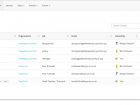5 Tips For Marketing Your Mental Health Provision More Effectively
5 Tips For Marketing Your Mental Health Provision More Effectively
5 ways to catapult your mental health provision out of teacher's inboxes and into their classrooms...
5 ways to catapult your mental health provision out of teacher's inboxes and into their classrooms...

I first conceived of this blog way back when the government was debating whether to make mental health education compulsory in schools back in November. When I finally started writing it we were in the middle of Mental Health Awareness week which just so happened to be the first week of SATs and exams. And now, as I finally get ready to publish it, we've recently celebrated World Mental Health Day - and it has just been announced that the number of children referred to mental health services has risen by more than a quarter in the last five years.
In short, news feeds are becoming increasingly saturated with ever-growing concerns for students' and teachers' rapidly deteriorating mental health.
What's the problem exactly?
Here are some of the current statistics surrounding mental health in schools:
-
1 in 10 students aged 5-16 have a diagnosable mental health condition (that's three per the average classroom).
-
54% of teachers have reported poor mental health, with 52% of this number saying their illness had been identified by a Doctor.
-
65% 14-18-year-olds said they would not be able to identify if they were experiencing mental health problem because they do not know enough about it.
-
8/10 teachers said poor mental health had a negative impact on the quality of their relationships with their students.
-
Rates of self-harm in girls aged between 13 and 16 have risen by 70% in three years.
-
Suicide is the biggest killer of young people under 35.
... And the list goes on.
Unfortunately (in most cases), teachers are not mental health experts. Although they have to adhere to Keeping Children Safe in Education/child protection regulations and guidance, they are not necessarily equipped to detect and manage mental health problems. Back in January, promises were made to "roll out mental health support to every school in the country," with the hope to have at least one teacher in every school trained in mental health first aid by September 2019. However, with no definite answer as to where the funding for this is coming from, schools remain reliant on their ever-dwindling budgets and the very little time they have in an already stretched working day to search for appropriate and impactful solutions.
... So what are we going to do about it?
While I am certainly no psychologist (for want of a few more qualifications!), I am an avid supporter of any organisation that aims to improve psychological wellbeing - as well as being a copywriter for Sprint Education! I'm therefore really glad to be taking this blog opportunity to share my 5 top tips on creating outstanding copy to successfully market your mental health provision to schools and teachers (don’t be disheartened if this isn't your department, though - the following tips work just as well for other products and services)!
5 top tips for successfully marketing your mental health provision to schools
1) Start with some hard and fast facts and stats
The first thing we need to do when marketing to teachers is capture their attention. Opening your email with an emotive fact or statistic is a great way to do this; and with the plethora of information surrounding mental health in the education sector currently available (including - and certainly not limited to - the stats I listed above), you're bound to find something that links specifically to your particular provision. Mental health is a hard-hitting topic, so don't be afraid to (mindfully) create some impact! Current and relevant facts and stats are also a great way to demonstrate your organisation as industry thought-leaders, and subsequently build trust in your brand.
2) Articulate the problem better than the teachers can
Teachers are, of course, acutely aware of the mental health crisis among themselves and their students. However, with so much else going on in their teaching day, it can be surprisingly difficult for them to put into words what their concerns actually are, or find the time to do so. By researching their fears and frustrations around student mental health (for example, a NASUWT teaching union poll found that over three quarters of teachers did not feel confident that they could get timely help for their students suffering with mental health difficulties) and mirroring teachers' internal dialogue in your copy, you will further build upon your foundation of trust.
3) Focus on your provision's benefits, not its features
It's a harsh reality, but teachers and schools don’t actually want your products or services. Yep, you read that right; what they actually want is results. For example, a teacher won't be interested in how many modules your mental health training course has, or what's in them; they just want to help their students to be happy, thriving, and ready to learn. So once you've captured their interest and earned their trust by establishing your knowledge and understanding, increase their desire for your mental health provision by promoting how it is going to help them. List these benefits in snackable bullet points - you can always pop in a link to a strong case study so they can read more into the benefits later!
4) Be mindful of your language
No, I'm not talking about swearing (though profanity isn’t ideal when marketing to schools, of course)! But being conscious of how you verbally communicate to teachers through your email copy is imperative to building interest and trust in your mental health provision.
For starters, ensure that you use spoken English, keeping your sentences short and free of complex jargon and using specific, definitive language to make your content clear and easy to understand from the off. As I mentioned in my Psychology of Marketing to Schools blog, it's also important to be empathetic in your writing, keeping teachers'/students'/schools' mental health interests in mind whilst gently pulling on the heartstrings of the emotional buyer within. Ensure you calibrate this "speech" to suit teachers' sophistication level so that they don't feel your knowledge is inferior/obvious, or that you're trying to sound smarter than them (both are instant switch-offs). It's a bit of a balancing act, but once you've got it, you'll be well on your way to running a successful mental health marketing campaign!
5) Don’t be afraid to go for the sale (but make sure the sales process is simple!)
One of the biggest fears that comes with copywriting is sounding too "salesy" or "pushy". Teachers are the most marketed-to people on the planet, so of course a hard-sale approach isn't likely to go down well. But keep in mind the primary aim of your provision; to improve mental health within the education sector. When you think of it this way, wouldn’t you be doing the teachers, students, and schools a disservice if you didn't persuade them to invest in your provision?
To help with this, ensure your main call to action makes it clear what the teachers need to do to access your provision; for example, by using a catchy, urgency-prompting call to action button with some sub-text briefly explaining the steps they need to take. Ensure you also eliminate any steps that make the sale long-winded or complicated and cause teachers to stop half way through the process.
Needless to say, these tips merely scratch the surface of a successful email marketing strategy! So don't forget...
You can find lots more tips and tricks to super-charge your email marketing in Sprint Labs and our other handy marketing to schools blog posts.
All that leaves me to say for today is a huge thank you and good luck to all the organisations out there striving to improve mental health in the education sector; at a time where the situation seems more desperate than ever, your efforts are very much appreciated!
Tags
Education Marketing
Email Calls to Action
Email Marketing
Emailing Schools
Emailing Teachers
How to Sell to Schools
How to Sell to Teachers
Marketing Strategy
Marketing to Education
Marketing to Schools
Marketing to Teachers
Similar Articles


VIDEO: School Priorities and How You Can Target Them
Teacher priorities for 2023, and how you can help schools achieve their goals with your products, services, and offers.


New Education Decision Makers for you to Reach
We've added data for Colleges, Universities, Local Authorities, and 185,000 new international contacts to our education database.


Expert marketing to schools support and solutions
Expert marketing to schools solutions
Email Head Teachers, Teachers, and Staff Inboxes
Email teachers and staff inboxes
Sell More to UK and Global Schools and Colleges
Sell more to schools and colleges

































